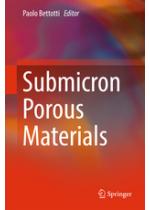Scale Transition for Mass Transport in Porous Structures

Authors |
G. Gavriil, F.A. Coutelieris |
Publication Year |
2017 |
Pages |
285-321 |
Edition |
1 |
Book Title |
Submicron Porous Materials |
Publisher |
Springer |
ISBN |
978-3-319-53033-8 |
Research Area |
Modelling of Transport Processes |
URL |
Book Contents:
The mass transport phenomena occurring in a porous media were studied in order to develop a fast and easy method of matching the macroscopic quantities (such as adsorption efficiency) during a scale transition process from mesoscopic to macroscopic (scale-up), or to microscopic (scale-down) and vice versa geometries. In order to be able to transit from one scale to another, the fundamental transport processes (laminar flow, convection, diffusion, and heterogeneous reaction) were detailed described for the three scales, following the same flow conditions given by the use of a dimensionless number, known as Peclet. After the simulation of the three scales, it was found that as Pe number increases, the adsorption efficiency
value becomes lower for all scales, meaning that as the convection increases the lower amount of the reactant reaches the catalytic surface in order to react. However, in the case of the unit cell model, this behavior was found to be accurate only for relatively low to medium Pe numbers (Pe < 50). For Pe numbers over 50, the velocity is found to reach extremely high values at the two points where the inlet surface meets the outlet surface, leading to discontinuities. Therefore, it is proved that the sphere-in-cell geometry is insufficient to accurate simulate transport phenomena for high Peclet numbers. Furthermore, the same effect of porosity on adsorption efficiency, was found for all scales, as it is observed that the λ value
increases, as porosity decreases. This phenomenon can be explained because as porosity decrease the catalytic surface, where the oxidization reaction takes place also increases. Hence, if the surface increases then the available surface for a reaction increases too. Finally a method of matching the geometrical parameters when scale transition occurs is proposed, underlying the necessary steps that should be followed. As the first step the calculation of the geometrical characteristics of the detailed geometry is a necessity as it will be the base where the transition will be relied on. Next, the inlet mixture flow needs to be adjusted in order to preserve the Pe number for all of the scales. Since the diffusion coefficients are practically constant, this adjustment can be made only by adapting the velocity to the necessary value. Finally, the last two most important adjustments are required to be made in order to have an identical characterization of the geometry without any discrepancies. The characteristic ratio, S/V of the porous material, is a measurement value of the available surface where the reaction may occur. By correctly adjusting this value, the geometry will have the same amount of reaction if it is simulated in any of the needed scales. Last but not least the average pore size needs to be adjusted proportionally to the transition ratio. If the average pore size is not adjusted correctly, it could lead to a discrepancy of the geometry as the hypothetical pores
would have been squeezed or extended in order to preserve that lower or higher void space, respectively.
